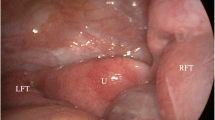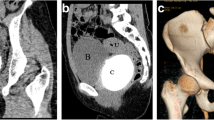Abstract
Persistent urogenital sinus (PUGS) is a congenital pathological condition characterized by an abnormal communication between the urethra and vagina, which has an estimated incidence of 0.6/10,000 female births. It could be the only known malformation or part of a syndrome. PUGS is commonly shown by a pelvic mass, related to a distended bladder, hydrometrocolpos which is due to an obstruction leading to the dilation of the vagina and uterus (i.e., imperforate hymen, transverse vaginal septum or atresia, and PUGS) or both. We present a case of female patient with classical congenital adrenal hyperplasia, diagnosed on the 7th day of life, with ambiguous genitalia, untreated surgically only with hormone therapy by parental decision. The patient, at the age of 5 years and 5 months, came to our observation for a pelvic ultrasound, which revealed retrovesical neoformation with anechoic content and regular walls. We performed the ultrasound examination that showed the dilation of the cervix and the vaginal canal with anechoic finely corpuscolated content in the declining portion, compatible with hydrometrocolpos from probable persistence of the urogenital sinus. The voiding cystourethrography (VCUG) confirmed the ultrasound diagnosis, with evidence of urogenital sinus. In conclusion, ultrasound is the first diagnostic tool, but need to be completed by other technical procedures, which VCUG or magnetic resonance imaging to observe the site of fusion of the urinary and genital tract.
Sommario
La persistenza del seno urogenitale (PUGS) è una rara condizione patologica congenita, caratterizzata da un’anomala comunicazione tra uretra e vagina, la cui incidenza è di 0.6/10.000 neonate. Clinicamente, può rappresentare l’unica malformazione rilevabile o far parte di un quadro sindromico. Si presenta comunemente come una massa pelvica, associata a distensione vescicale e/o idrometrocolpo, ossia dilatazione della vagina e dell’utero causata dall’accumulo di secrezioni cervicali conseguente ad un’ostruzione (imene imperforato, setto vaginale trasverso, atresia vaginale e PGUS). Viene presentato il caso di una paziente di sesso femminile, affetta da Sindrome Adreno-Genitale (SAG) forma classica, diagnosticata al 7° giorno di vita, con genitali ambigui (ipertrofia clitoridea, grandi labbra scrotalizzate) non trattati chirurgicamente per decisione parentale, in terapia ormonale sostitutiva. La paziente, all’età di 5 anni e 5 mesi, giunge alla nostra osservazione per una richiesta di ecografia della regione pelvica richiesta, come consulenza, per una neoformazione retrovescicale a contenuto anecogeno e pareti regolari. L’esame ecografico ha mostrato una dilatazione del collo e del canale vaginale a contenuto anecogeno finemente corpuscolato nella porzione declive, compatibile con idrometrocolpo da verosimile persistenza del seno urogenitale. La cistouretrografia ha confermato il reperto ecografico, con evidenza del seno uro-genitale. In conclusione, l’ecografia è la metodica di prima istanza utilizzata, tuttavia necessita di ulteriori metodiche, quali la Cistouretrografia e/o la Risonanza Magnetica per rilevare il punto di comunicazione tra il tratto urinario ed il tratto genitale.



Similar content being viewed by others
References
Valentini AL, Giuliani M, Gui B, Laino M, Zecchi V, Rodolfino E, Ninivaggi V, Manzoni C, Bonomo L (2016) Persistent urogenital sinus: diagnostic imaging for clinical management. What does the radiologist need to know? Am J Perinatol 33:425–432
Kitta T, Kakizaki H, Iwami D, Tanda K (2004) Successful bladder management for a pure urogenital sinus anomaly. Int J Urol 11:340–342
Taori K, Krishnan V, Sharbidre KG, Andhare A, Kulkarni BR, Bopche S, Patil V (2010) Prenatal sonographic diagnosis of fetal persistent urogenital sinus with congenital hydrocolpos. Ultrasound Obstet Gynecol 36:641–643
Vitale V, Cigliano B, Vallone G (2013) Imperforate hymen causing congenital hydrometrocolpos. J Ultrasound 16:37–39
Sidatt M, Wedih AOSM, Boubaccar AO, Litime AOE, Feil A, Moussa AO (2013) Hydrocolpos and hydrometrocolpos in newborns. Arch pédiatrie organe Off la Sociéte Fr pédiatrie 20:176–180
Witters I, Meylaerts L, Peeters H, Coumans A, Wirjosoekarto S, Fryns JP (2012) Fetal hydrometrocolpos, uterus didelphys with low vaginal and anal atresia: difficulties in differentiation from a complex cloacal malformation: a case report. Genet Couns 23:513–517
Subramanian S, Sharma R, Gamanagatti S, Agarwala S, Gupta P, Kumar S (2006) Antenatal MR diagnosis of urinary hydrometrocolpos due to urogenital sinus. Pediatr Radiol 36:1086–1089
Brien JC, Shariat SF, Herman MP et al (2010) Preoperative hydronephrosis, ureteroscopic biopsy grade and urinary cytology can improve prediction of advanced upper tract urothelial carcinoma. J Urol 184:69–73
Mohmand H, Goldfarb S (2011) Renal dysfunction associated with intra-abdominal hypertension and the abdominal compartment syndrome. J Am Soc Nephrol 22:615–621
Chavhan GB, Parra D, Oudjhane K, Miller SF, Babyn PS, Pippi Salle FL (2008) Imaging of ambiguous genitalia: classification and diagnostic approach. Radiographics 28:1891–1904
Celayir YC, Kurt G, Ceyhan S, Cici I (2013) Spectrum of etiologies causing hydrometrocolpos. J Neonatal Surg 2:2–5
Bhargava P, Dighe M (2009) Prenatal US diagnosis of congenital imperforate hymen. Pediatr Radiol 39:1014
Berrocal T, López-Pereira P, Arjonilla A, Gutiérrez J (2002) Anomalies of the distal ureter, bladder, and urethra in children: embryologic, radiologic, and pathologic features. RadioGraphics 22:1139–1164
Ryu J, Kim B (2001) MR imaging of the male and female urethra. Radiographics 21:1169–1185
Acknowledgements
The authors thank Billy Samuel Hill for the linguistic review.
Author information
Authors and Affiliations
Corresponding author
Ethics declarations
Conflict of interest
The authors declare that they have no conflict of interest.
Ethical approval
All procedures performed in studies involving human participants were in accordance with the ethical standards of the institutional and/or national research committee and with the 1964 Helsinki declaration and its later amendments or comparable ethical standards.
Human and animal rights
This article does not contain any studies with animals performed by any of the authors.
Informed consent
Informed consent was obtained from all individual participants included in the study.
Rights and permissions
About this article
Cite this article
Simonetti, I., Trovato, P., Verde, F. et al. A rare case of hydrometrocolpos from persistent urogenital sinus in patient affected by adrenogenital syndrome. J Ultrasound 21, 249–252 (2018). https://doi.org/10.1007/s40477-018-0290-9
Received:
Accepted:
Published:
Issue Date:
DOI: https://doi.org/10.1007/s40477-018-0290-9




